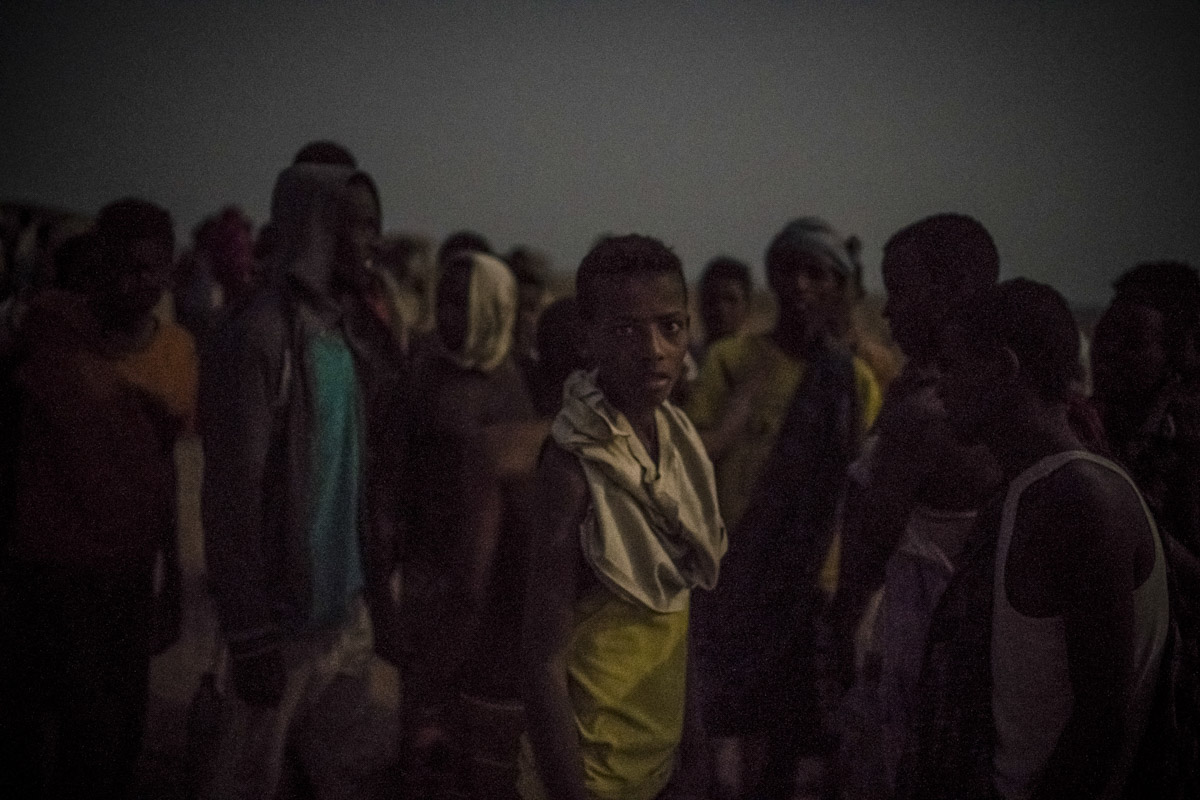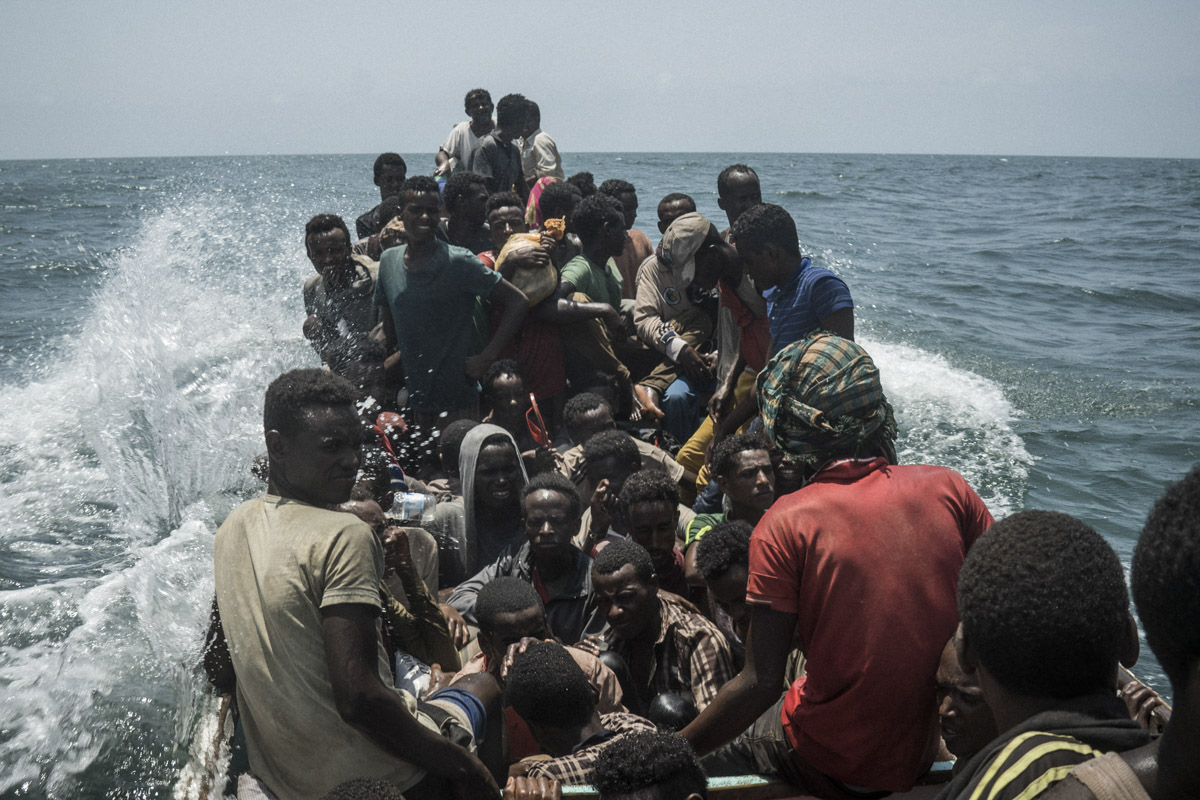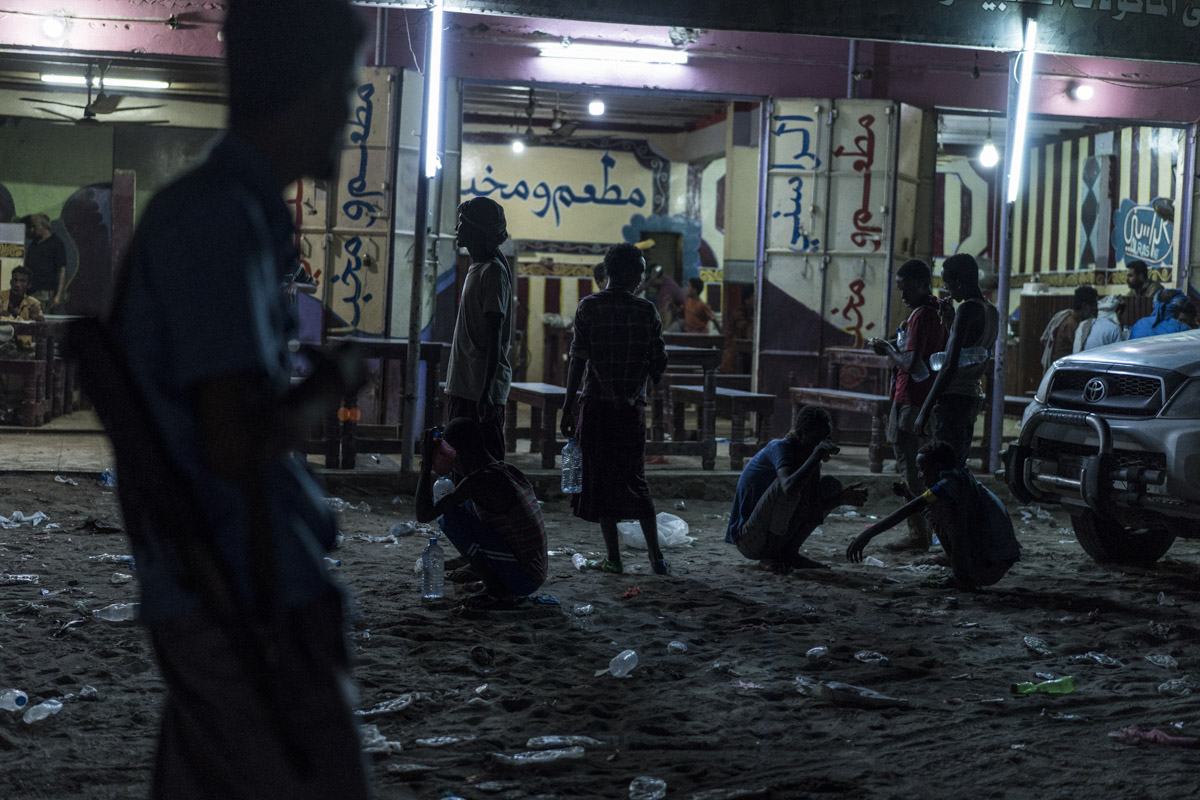The Ethiopian Oromo population is destitute. Dozens of thousands of them irregularly travel to Saudi Arabia, in hope of a better future. But their crossing is a long, perilous, almost impossible one. People walk their way from Ethiopia, across Djibouti, and Yemen because they can’t afford to pay a smuggler. The first trap is made of the Galafi Mountains, between Ethiopia and Djibouti where the heat and the thirst kill. Then comes Obock, the small port where the migrants arrive at night to face the Red Sea over overcrowded dhows. Finally comes Yemen, where local bandits infiltrate the migration economy. In Yemen, the Oromos become an easy prey as the poorest are taken away from their route, kidnapped by the wrong smugglers, and tortured until their families pay the ransom. Some of them have to sell all their lands to free a son or a boy from torture hell holes. From one Aden Gulf shore to the other, we have walked with the Ethiopian Oromo people. From the pieces of their odyssey, we wish to tell the story of a mortal crossing, where only the hope for a better future keeps one alive. This is the portrayal of the Oromo people, transfigured by hardships.

Hundreds of Oromo migrants smuggle across the mountainous border from Ethiopia to Djibouti.
It's one of the hottest regions in the world.
Galafi, Djibouti.

Hundreds of Oromo migrants smuggle across the mountainous border from Ethiopia to Djibouti.
It's one of the hottest regions in the world.
Galafi, Djibouti.

Hundreds of Oromo migrants smuggle across the mountainous border from Ethiopia to Djibouti.
It's one of the hottest regions in the world.
Galafi, Djibouti.

The Oromo migrants are resting after a 2 days walk to enter Djibouti. Here, local villagers are selling beverage.
Galafi, Djibouti.

A young Oromo man has just fainted. Exhausted, dehydrated, he owes his life to his friends who carried him over the last kilometers.
Galafi, Djibouti.

The Oromo migrants walk across the desert for about 250 kilometers to reach the port of Obock, from where they will leave Djibouti.
Their belongings fit in one bag.
Galafi, Djibouti.

A 25-year-old Ethiopian woman named Magdess died from dehydration after a six-days walk.
Obock, Fatiharo ghetto, Djibouti.

This group rented the corner of a house in construction to Djiboutian villagers. All along their way, Oromo migrants shape the local economy.
Dikhil, Djibouti.

After a 3-days walk through Djibouti, the migrants reach the strait of Bab El Mandeb, between the Aden Gulf and the Red Sea. It is the first time to see the sea for a majority of the Oromo people. It will take them about 6 hours to navigate between Djibouti and Yemen. Some traditional boats can board up to 300 clandestine passengers.
Obock northern beach, Djibouti.

After a 3-days walk through Djibouti, the migrants reach the strait of Bab El Mandeb, between the Aden Gulf and the Red Sea. It is the first time to see the sea for a majority of the Oromo people. It will take them about 6 hours to navigate between Djibouti and Yemen. Some traditional boats can board up to 300 clandestine passengers.
Obock northern beach, Djibouti.

About a thousand people illegally leave Djibouti every night to Yemen from an unwatched shore north of Obock city. Oromos will navigate across the Bab El Mandeb strait (the "gate of lamentation"), separating Djibouti from Yemen.
A dhow can board a hundred people. It takes them about 6 hours to reach Yemen. One out of four migrants there are women.
Obock, Djibouti

About a thousand people illegally leave Djibouti every night to Yemen from an unwatched shore north of Obock city. Oromos will navigate across the Bab El Mandeb strait (the "gate of lamentation"), separating Djibouti from Yemen.
A dhow can board a hundred people. It takes them about 6 hours to reach Yemen. One out of four migrants there are women.
Obock, Djibouti

About a thousand people illegally leave Djibouti every night to Yemen from an unwatched shore north of Obock city. Oromos will navigate across the Bab El Mandeb strait (the "gate of lamentation"), separating Djibouti from Yemen.
A dhow can board a hundred people. It takes them about 6 hours to reach Yemen. One out of four migrants there are women.
Obock, Djibouti

On the dhow, navigating towards Yemen.
Seventy people boarded the dhow for a 4 to 6 hours sea journey. The strait of Bab El Mandeb is a strategic area for the oil tankers and the war ships navigating between the African continent and the Middle East. Every year, migrants drown in the strait.
Bab El Mandeb strait

On the dhow, navigating towards Yemen.
Seventy people boarded the dhow for a 4 to 6 hours sea journey. The Bab El Mandeb strait is a strategic area for the oil tankers and the war ships navigating between the African continent and the Middle East. Every year, migrants drown in the strait.
Bab El Mandeb strait

On the dhow, navigating towards Yemen.
An Oromo teenager navigating to Yemen on an overcrowded dhow. The hardest part of her trip is yet to come: irregularly travelling across a country at war.
Bab El Mandeb strait

On the dhow, navigating towards Yemen.
Seventy people boarded the dhow for a 4 to 6 hours sea journey. The Bab El Mandeb strait is a strategic area for the oil tankers and the war ships navigating between the African continent and the Middle East. Every year, migrants drown in the strait.
Bab El Mandeb strait

The Oromos start their long walk throughout Yemen, a country ravaged by a civil war.
Ras Al Arah, Yemen.

The Oromos start their long walk throughout Yemen, a country ravaged by a civil war.
Ras Al Arah, Yemen.

The poorest migrants have to walk across Yemen. About a thousand kilometers separates them from the Saudi border. a majority of them doesn't make it. Exhaustion, kidnapping, dehydration... The Oromos crossing is a mortal one.
Qawah, Yemen.

Between Ras Al Arah and Aden. It takes between four to five days of arduous walk to reach Aden, the yemeni economical capital.
Yemen

Ras al Arah check-point. Yemeni militiamen let the migrants walk free. Migration for the local people in Southern Yemen is a major source of income.
Ras Al Arah, Yemen.

The Oromo teenager has walked for the past four days without eating any food.
Ras Al Arah, Yemen.

Between Ras Al Arah and Aden. The Oromo people walk for four to five days to reach Aden, the yemeni economical capital. Most of the women have sufficient money to pay for a car ride to Aden but some of them still have to walk among men.

These young men were the lucky ones and run away to eat the little food that was offered to them.

Near an abandoned stadium, Aden. Many migrants reach Aden penniless while the war prevents them to move forward. They beg or try to find a low-paid job to continue their journey.
Aden, Yemen.

Between Ras Al Arah and Aden. The Oromo people walk for four to five days to reach Aden, the yemeni economical capital. Migrants wait near local restaurants to beg for the leftovers.

Between Ras Al Arah and Aden. The Oromo people walk for four to five days to reach Aden, the yemeni economical capital. Migrants wait near local restaurants to beg for the leftovers.

A majority of the women travel on livestock trucks. Some smugglers call these trucks the "VIP rides". The possibility to reach their destination is higher but the risk of dehydration too.

Between Ras Al Arah and Aden. The Oromo people walk for four to five days to reach Aden, the yemeni economical capital. Migrants wait near local restaurants to beg for the leftovers.





























